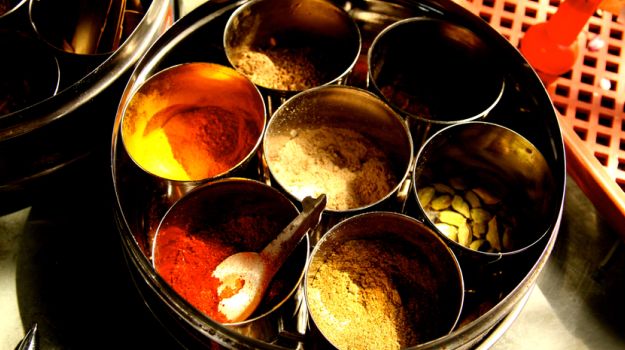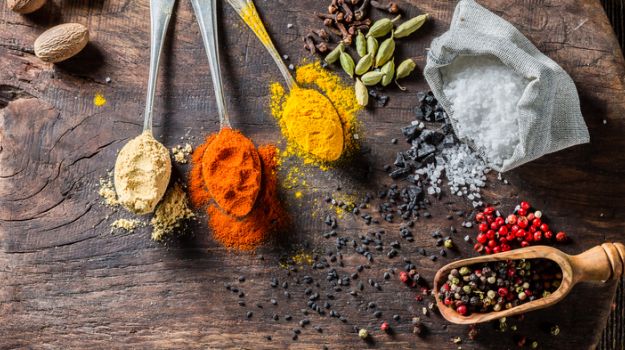Lentils are commonly tempered with asafoetida and vegetables that are not cooked using either onion or garlic to flavour them are invariably flavoured with hing, the Hindi word for the spice. In fact, hardly do you come across a curry with an onion masala as its base that also uses hing. Similarly dals, when they are tempered with garlic, a strong ingredient, are not tempered with hing at all.
The reason for this goes beyond the ritualistic. Asafoetida in fact contains sulphide compounds whose flavour profile is pungent and quite similar to what you get from onion and garlic. Hing, as a flavouring agent, is thus simply a substitute for pyaaz and lehsun, and approximates the same flavours as the latter.

Benefits of hing: Asafoetida contains sulphide compounds whose flavour profile is pungent and similar to onion and garlic
Hing - The Pungent Spice
Though widely used in the cuisines of the Subcontinent, hing arrived here via Iran and Afghanistan, thanks to ancient trade, once the land route between Asia Minor and India began to be traversed widely. We can find traces of this link even today: the best hing is still Kandahri hing, with a stronger, more prominent smell.
The spice is actually a resin-like gum that comes from the stem and roots of the plant. It is dried and used, and since it is difficult to be grated, has to be crushed into a powder. What we commonly use today in our kitchens is not pure hing either. Most of it is a compound, which just has 30 per cent asafoetida, the rest rice flour and other gum.
Cooking With Hing
Since it is a strong spice, cooking with hing requires some skill. You need to add just a small pinch to large portions of dal or curry; adding it to heated oil or ghee first so that the flavours are released. Less skilful cooks often burn the hing in the process and you can make that flavour out in the final dish. The task of letting it heat in oil just till the time it releases its flavours and aroma is delicate and can mark a skilled cook from a casual one.
Cooking with hing is thus much more subtle than cooking with garlic, whose overwhelming flavour can drown out every other flavour in the dish. Hing, while it has the same flavour pattern and is also quite strong, is always used in judiciously tiny amounts to balance flavours.

Benefits of hing: Cooking with hing is thus much more subtle than cooking with garlic
Benefits Of Hing
What it is also thought to traditionally do is balance the doshas, according to Ayurveda, particularly vata and kapha - air and water. One of the best spices to use during the rains, it enhances digestion, relieves colic pain and flatulence.
A common home remedy for children with bloated stomachs is to smear their abdomen with a little asafoetida dissolved in water. This is a cure in both India and Thailand. However, even western medicines often use the ingredient in their digestive preparations.
The ingredient is believed to be also anti-epileptic and an antidote for opium. But, it is its use in fighting influenza that has been widely studied. For a long time, asafoetida was a folk remedy for colds and asthma. In 1918, it was used to fight the Spanish influenza epidemic. But, it is only now - in 2009 - that some research has reported that it contains antiviral compounds that can be effective against strains such as the H1N1. The humble hing in fact is quite a super food in its own right, even if it is not as fashionable as others.
Benefits of hing: Hing is believed to be also anti-epileptic and an antidote for opium
Anoothi Vishal is a columnist and writes on food for The Economic Times and NDTV Food, and runs the blog amoveablefeast.in. She tracks the business of restaurants and cuisine trends and also researches and writes on food history and the cultural links between cuisines. Anoothi's work with community-based cuisines led her to set up The Great Delhi Pop-Up three years ago, under which she promotes heritage, regional and community-based cuisines as well as researched and non-restaurantised food concepts. She has also been instrumental in reviving her own community's Kayastha cuisine, a blend of Indo-Islamic traditions, which she cooks with her family and has taken across India to a diverse audience.Disclaimer:The opinions expressed within this article are the personal opinions of the author. NDTV is not responsible for the accuracy, completeness, suitability, or validity of any information on this article. All information is provided on an as-is basis. The information, facts or opinions appearing in the article do not reflect the views of NDTV and NDTV does not assume any responsibility or liability for the same.











